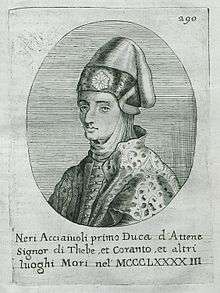Francesca Acciaioli
Francesca Acciaioli or Acciajuoli (died 1430) was the wife of Carlo I Tocco, Count Palatine of Cephalonia and Zakynthos.
Early life

Francesca was the younger of the two daughters of Nerio I Acciaioli and Agnes de' Saraceni.[1][2] Nerio Acciaioli—a scion of a prominent banking house of Florence—moved to Frankish Greece in the 1360s.[3] Initially, he acted on behalf of his powerful kinsman, Niccolò Acciaioli, who adopted him as his son.[4] Nerio seized large domains in the Principality of Achaea: Niccolò's son, Angelo, mortgaged Corinth to him and Nerio captured Megara by force.[5][6] Francesca's maternal grandfather, Saraceno de' Saraceni, was a Venetian citizen in Negroponte.[7] Nerio and Agnes get married before 1381.[2]
Negotiations about Francesca's marriage with a son of Felipe Dalmau, the vicar-general of the Duchy of Athens, were futile in 1382.[8] Plans about Francesca's marriage with Angelo Acciaioli's son did not materialize either in 1388.[8] By 1388, Nerio became the actual ruler of the Duchy of Athens.[9]
Countess
Francesca was given in marriage to Carlo I Tocco, Count Palatine of Cephalonia and Zakynthos between 1388 and 1393.[10] Carlo I's mother, Maddalena de' Buondelmonti, had arranged the marriage, expecting that Francesca was to inherit parts of her father's domains, because she had no legitimate brothers.[10] According to canon law, the marriage was incestuous, because Maddalena was Niccolò Acciaioli's niece, but its legality was never questioned.[10]
References
- Lock 1995, p. 368.
- Setton 1975, p. 232.
- Lock 1995, p. 129.
- Lock 1995, pp. 130–131.
- Lock 1995, p. 131.
- Fine 1994, p. 249.
- Setton 1975, pp. 232, 801.
- Stathakopoulos 2018, p. 242.
- Zečević 2014, p. 54.
- Zečević 2014, p. 55.
Sources
- Fine, John Van Antwerp (1994) [1987]. The Late Medieval Balkans: A Critical Survey from the Late Twelfth Century to the Ottoman Conquest. Ann Arbor, Michigan: University of Michigan Press. ISBN 0-472-08260-4.
- Lock, Peter (1995). The Franks in the Aegean, 1204–1500. Longman. ISBN 0-582-05140-1.CS1 maint: ref=harv (link)
- Setton, Kenneth M. (1975). "The Catalans and Florentines in Greece, 1380–1462". In Setton, Kenneth M.; Hazard, Harry W. (eds.). The History of the Crusades, Volume Three: The Fourteenth and Fifteenth Centuries. The University of Wisconsin Press. pp. 225–277. ISBN 0-299-06670-3.CS1 maint: ref=harv (link)
- Stathakopoulos, Dionysios (2018). "Sister, Widow, Consort, Bride: Four Latin Ladies in Greece (1330–1430)". In Lymberopoulou, Angeliki (ed.). Cross-Cultural Interaction Between Byzantium and the West, 1204–1669: Whose Mediterranean Is It Anyway?. Routledge. pp. 236–. ISBN 978-0-8153-7267-7.CS1 maint: ref=harv (link)
- Zečević, Nada (2014). The Tocco of the Greek Realm: Nobility, Power and Migration in Latin Greece (14th-15th centuries). Makart. ISBN 978-86-87115-11-8.CS1 maint: ref=harv (link)